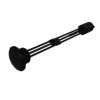If you have not already figured this out, I will offer some guidance here. I have extensive experience with these machines but my comments here may be worth what you pad.
It is a poor design to begin with and most other brands of machines have a superior choice of fittings in this area.
First check the durometer of the O-ring you are installing. This is a 5,000 psi circuit you are working with. Not all O-rings perform at these pressures.
When tightening make sure your tools are not contacting other fittings and fooling you about the torque applied. This can easily happen on these hoses.
Locktite is your friend. Specifically, locktite 545 can be used on these threads and will stop the fittings from loosening up in operation. This product is designed to be used with hydraulics and will not destroy the hydraulic system if you get contamination of the fluid. Don't expect to find this locally. Ebay and Amazon are your friend.
You're probably already doing this. Make sure everything is spotlessly clean. One grain of sand can destroy the O-ring when reassembling. Make sure the O-ring is not rolled or pinched when re assembling.
These fittings are problematic on these machines. Debris getting into this area can and will knock the fittings loose.
If you're already working on these hoses, it is worth the effort to check the routing for the speed sensor wire. This wire can be routed in the center of the hydraulic hoses and have the bundle zip tied together so that the hoses protect the wiring and connector for the speed sensor. Speed sensors are a known issue on these machines and damage to the wiring is usually the issue. Using the hoses in this way is well worth the effort in my experience.
To the engineers that design this. I hope I never meet you in person because I will probably end up in jail. Why can't we just have JIC fitting. They just work without all this ridiculous bs with O-rings. Bobcat uses flange bolt type fitting in this area, and they are very reliable connections in this area.
Also, these hoses tend to wear they go through the frame. It is worth the effort to add some protection to make these hoses last longer. I have added a piece of split 3-inch green suction hose around the bundle of hydraulic hoses in this area. A pain to add but so is changing these hoses.
If you're running this machine in any sort of production environment, I would consider keeping spare hoses of all the hoses that go to the drive motors.
Lastly and you probably already know this be very meticulous about cleanliness when working in this area. It is easy to contaminate the system while working in this area. Failure of the drive motors is the number one hydraulic problem on these machines and the filtration is woefully inadequate to prevent a failure in general much less if you inadvertently introduce contaminates in the drive motor circuit or any other for that matter.
Good luck these machines are unreliably and poorly engineered at best in my experience. I have had multiple of these machines with warranty claims approaching or exceeding the cost of the machine itself not including downtime cost.

